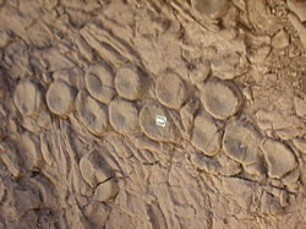Intelligent Kraken Sea Monster Purposefully Arranged Ichthyosaurs Bones in Its Lair [VIDEO]

A giant sea monster, possibly a Kraken, might have preyed on 45-foot-long Ichthyosaurs - drowning them or breaking their necks - before purposefully arranging the beasts' bones in its lair, a paleontologist said.
Mark McMenamin, a paleontologist at Mount Holyoke College in Massachusetts, studied the remains at a dig-site at the Berlin-Ichthyosaur State Park in Nevada. The site is where the remains of nine 45-foot (14-meter) ichthyosaurs, of the species Shonisaurus popularis are found.
Ichthyosaurs are considered the Triassic's equivalent to today's giant squid-eating sperm whales. Snaggle-toothed ichthyosaurs grow larger than school buses and they were at the top of the Triassic Period ocean food chain.
McMenamin thinks the Kraken, which would've been nearly 100 feet (30 meters) long, may have taken out these beasts.
Krakens are considered mythical creatures and there is no evidence of them. They are also soft-bodied and it is hard to present a firm case of existence of for them.
But what McMenamin saw at the Nevada dig-site surprised him. The different types of etching on the bones suggested that the shonisaurs all killed and buried at different times. Additionally, the bones looked as if they were purposefully rearranged.
These signs caused McMenamin to wonder what modern predator possessed this sort of intelligence to manipulate bones just as the ones at the dig-site were.
Modern octopus will do this, McMenamin said in a statement issued by The Geological Society of America. I think that these things were captured by the kraken and taken to the midden and the cephalopod would take them apart.
McMenamin noticed that in the fossil bed some of the shonisaur vertebral disks are arranged in curious linear patterns with what he said is almost geometric regularity. He thinks the proposed Triassic kraken, which could have been the most intelligent invertebrate ever, possibly arranged the vertebral discs in double line patterns.
The Triassic period that lasted from 248 million to 206 million years ago.
But could an invertebrate have taken down such a large reptile?
The fossils at the Nevada site have also perplexed researcher Charles Lewis Camp of U.C. Berkeley, who is considered an expert on the site, since the 1950s.
Camp believed that the fossils were possibly a result of death by an accidental stranding or perhaps a toxic plankton bloom. However, no one has been able to prove that such a beast really died in shallow water. And more recent work on the rocks that are around the fossils suggests that the creatures might have succumbed in a deep water environment, making the arranged bones even more mysterious.
So did the shonisaur have a shallow or deep ocean death and how could the spineless Kraken take out such a large reptile?
A few years ago, staff at the Seattle Aquarium set up a video camera one night in order to find out what was killing the sharks in one of the large tanks they had. They found that a large octopus that swam the same tank was murderer.
McMenamin thinks the same thing is what happed during the Triassic.
It was either drowning them or breaking their necks, he said of the perfect Triassic crime. Perfect because octopuses are mostly soft-bodied and they don't fossilize well. Researchers said only their beaks, or mouth parts, are hard and that there is a low chance of those being preserved nearby.
Therefore, it is only circumstantial evidence that the Kraken is the culprit, leaving much skepticism.
We're ready for this, McMenamin said. We have a very good case.
Watch a shark versus octopus video below and decide.
Also Read: Germany's Defunct ROSAT Satellite Fall Site Remains a Mystery
© Copyright IBTimes 2025. All rights reserved.






















